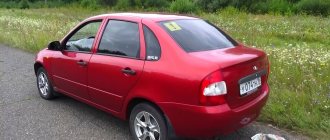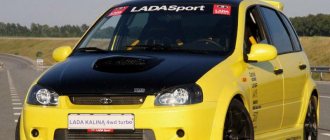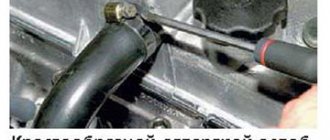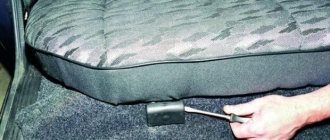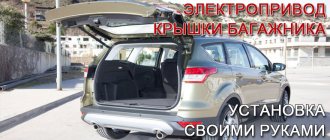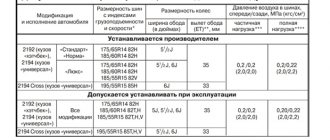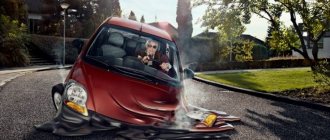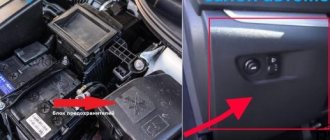New Lada Kalina: answering the most interesting questions Almost 9 years have passed since VAZ presented the Lada Kalina model.
And only quite recently did Russian motorists have the opportunity to “taste” the fruits of the updated second-generation model? What has changed? Have all the shortcomings been eliminated? AutoVesti headed to Togliatti for answers to these questions. However, today our report will not be built in the traditional descriptive style, but in the form of answers to questions asked by our readers. Judging by the number of questions we received, it is immediately clear what a sensation this year’s new VAZ product created. Is this really a new car, or are we talking about a banal restyling? So let's get started. How much has the body changed, and on what platform is the new Lada Kalina built?
Today, it is too expensive for the Volzhsky Automobile Plant to make a new platform for Kalina. Therefore, the platform remained the same, VAZ 2190, on which, in addition to the Kalina, the Grant was built. By the way, after minor changes, the same platform will be used in cars of the Japanese brand “Datsun”. The fact is that it attracts the Japanese with its cheapness.
The body of the Lada Kalina also did not undergo major changes; they limited themselves to minor changes. I would like to note right away that there will be no sedan in the new range; there is a Granta for this purpose. The hatchback and station wagon of the new Kalina have changed wings, bumpers and rear side windows. As for the front part of the body, the new Kalina inherited the front fenders and hood from the Granta; the radiator grille, headlights and bumper are unique here. The length of the Kalina has increased by 4.4 centimeters due to the new engine radiator.
For the same reason, the front bumper now protrudes forward more. For the first time, the Kalina station wagon has roof rails; they will be supplied in all trim levels. However, having received a new bumper, Kalina lost its amplifier, which covered the evaporator and radiator of the Condeya during accidents at low speeds. VAZ employees argue for this fact by saying that when they conducted a test drive at low speeds, up to 15 km/h, it was noticed that the new bumper perfectly protects the air conditioner components since it has internal stiffeners. But personally, we had another question: “How long will we have to wait for a new bumper to replace the broken one?” After all, our domestic manufacturer is very lame in terms of timely supply of spare parts for new products. I remember a situation when a friend of mine, who purchased a new Priora in 2007, which had just gone on sale at that time, spent several days calling Moscow and Tolyatti in a vain search for a new mirror to replace the one that had been demolished by a truck. I would like to think that a lot has changed since then...
So, let's move on. There will be no lensed headlights, as on the concept; only daytime running lights have appeared. However, the new product will receive the conceptual color “Magma”, and for it, like for other colors in the “metallic” range, you will not have to pay extra. In some trim levels, the daytime handles are painted in body color. For the first time, Kalina began to have an electric drive for the fifth door lock in the Lux and Norma configurations. Now the door can be opened either with a key, on the panel or using a key fob. However, upon closer examination, it turned out that the standard button for opening the fifth door was missing.
The dashboard is made of plastic. It is tough, but of sufficient quality. The dashboard itself looks smooth and does not creak when driving on rough roads. In the car's interior, as in the Grant, there is a steering wheel with a column, a tray for small items, and side air deflectors. The new Kalina has a higher quality multimedia system with a touch screen made in Russia. It is planned to supplement the multimedia system with a GPS/GLONASS navigator at the end of 2013. 2)
What changes have been made to the interior, has it become smaller?
Since the body of the new Kalina remained unchanged, the dimensions of the interior remained the same. Everything here is also spacious; tall people can sit comfortably both in front and in the back. At the same time, a lot of new things appeared in the cabin. Internal door panels with wide armrests were borrowed from the Granta, an eyeglass case appeared above the driver’s head, and a loop-cup holder was added to the rear seats on the handbrake housing, where a small bottle of water could fit. The rear seat belt buckles have been carefully placed in a special mesh, and a buzzer has also been added to notify you that the front seat belts are not fastened.
In addition to the little things, the new Kalina received a new dashboard. Moreover, a new climate control system was immediately designed; it now has a low noise level, is well laid out, and its air ducts are securely attached. In the “Norma” configuration, the car will be equipped with a conventional air conditioner, and in the “Lux” version a new climate system from Visteon will be installed. The system itself will control the temperature, direction of air flow and intensity. However, VAZ workers noted that climate control takes power away from the engine, but you have to sacrifice something for comfort.
The Russian company supplies an instrument panel with a route controller borrowed from Granta. The Kalina has unique tachometer and speedometer scales, however, like the Granta, it does not have a lamp indicating overheating. However, on the other hand, this is good, since in a car with an automatic transmission, the screen in the right corner shows not only the gearbox range, but also the gear number itself. In the “Lux” configuration, “Kalina” sports a new multimedia system that has a touch screen located high, which makes it easy to look at even when driving. Although this looks still unusual in Russian cars. To be honest, the shiny black control buttons don't quite fit into the overall design of the dashboard.
The USB connector is hidden in the glove compartment, although it would be much better to put it in a compartment under the cigarette lighter. The multimedia system itself is beautifully designed, but as soon as we started viewing large photos, the system began to noticeably slow down. And the interface is quite complex and incomprehensible; drivers will have to get used to it for a long time. At the same time, we were able to synchronize the system with an iPhone via Bluetooth and play music through the phone and receive phone calls. However, the system flatly refused to synchronize via the USB port, limiting itself to only recharging.
As for the seats, the situation is even worse. They have not changed in the new product and remain amorphous and soft. The promised height-adjustable driver's seat, which the plant planned to produce, has not yet been released. Moreover, it is quite problematic to pull out the headrest without special knowledge: you need to know where to pull, where to pry, and at what point in time to release the latches. If such head restraints will be in production models, then it’s too early to talk about new seats, at least AvtoVAZ has brought the old ones to mind. The same applies to steering wheel adjustment. And at the same time, the new product is positioned as a car for guys and girls!
What kind of engines will there be and are they afraid of the timing belt breaking?
The second Kalina received three gasoline engines. They, as in the first version, will run on 95 gasoline. It is clear that the engine is more agile, but what can you do when only 92nd gasoline is available at domestic gas stations? The “Norma” and “Standard” trim levels will have a 1.6-liter eight-valve engine with a capacity of 87 horsepower called VAZ-11186. It will develop a torque of 140 Nm, which is more than the previous Kalina. Will it be available with a 1.4-liter four-cylinder engine? No.
In the “Lux” configuration, a sixteen-valve engine with an improved intake system with a volume of 1.6 liters is available. The engine works in tandem with a five-speed manual transmission and is capable of developing power up to 106 horsepower. This raised a number of questions among motorists. After all, for example, in Moscow the transport tax will increase because of this. To this question, AvtoVAZ employees answered that the torque increased to 148 Nm, and the engine became more responsive and high-torque in the operating range of 1000-2500 rpm. In fact, the employees’ words were confirmed, and the engine really accelerates the car perfectly from medium speeds and drives more confidently from the bottom. Fuel consumption on the highway was 10.5 liters per 100 kilometers. The engine has a two-chamber intake receiver, which is designed to improve the filling of the combustion chambers during the intake stroke at different crankshaft speeds. The new Kalina maintained a 15,000-kilometer period between maintenance visits, but the first maintenance at 2,000 kilometers was cancelled. Change the oil in the automatic transmission every 60 thousand kilometers.
Backseat
The doors to the salon open wide, which is convenient for a large person or if you suddenly need to put something down. The door handles inside the cabin are painted silver. The locks are recessed. The windows in the rear seat are mechanical. The station wagon package comes with speakers in the doors. Four speaker audio.
The rear seat is standard, designed for three people. For safety, headrests and seat belts are installed.
The limit switches for turning on the lighting and alarm are made in a non-standard manner - in the form of rubber inserts.
Exterior of Lada Kalina 2
Unlike the first version, Lada Kalina is now available in two body types: hatchback and station wagon; the sedan version has disappeared from the line; now AvtoVAZ offers to purchase a B-class sedan in the form of the Lada Granta. As you can see in the photo, the color range has expanded, adding blue, red and orange colors with a metallic sheen. Painting bumpers to match the body has become available in a minimal assembly.
The shape of the roof on the hatchback remained the same, but on the station wagon it was fundamentally changed and received, in addition, roof rails. The optics of the modified Lada Kalina received built-in daytime directional lights in the minimal version. A fairly large air intake on the front bumper is quite appropriate, given the most powerful power unit available for the new second generation Lada Kalina. The location of the rear lights remains almost the same as in the first version of the model.
The body of the new Kalina has become stiffer, and a frontal impact energy absorption zone has appeared, resulting in increased passenger safety indicators. Also, the body received galvanization on almost 40% of the surface, the overall dimensions of the model and ground clearance were slightly increased, which became comparable to the ground clearance of some crossovers.
Interior and driver's seat
We continue our Lada Universal test drive. The side mirrors are very convenient for viewing. There are several buttons on the driver's side door: raising and lowering the window, locking the doors.
The design of the panel is pleasing to the eye, there are no unnecessary details - everything is concise and neat. There is an airbag on the passenger side of the front seat. Below is a standard medium-sized glove compartment, where, when opened, the backlight automatically turns on, even without the ignition key. The air ducts follow the design from Renault cars.
In the luxury version, a monoblock is installed in place of the radio, which is often broken. Videos on it are played only in a certain format, which limits interaction with it. In a station wagon, you can buy any radio and install it without any problems, because all wires are already connected.
Under the monoblock there are heating controls, ventilation for heat or cold and air conditioning. The “Norma +” package includes heated front seats. If you don’t smoke, then instead of the cigarette lighter you can normally use this place to charge your smartphone, navigator, and so on.
This configuration of the Lada Kalina 2 station wagon has a manual transmission. It will take some time to get used to shifting into 5th gear. It is located a little far away.
It is also worth paying attention to a small feature of switching reverse gear. On classic cars it was necessary to retract the handle, now you just need to hear a characteristic click and only after that you need to back off. If you are used to keeping your hand on the gearbox while driving, then thanks to the cable transmission, vibration is almost not felt.
It is worth mentioning separately about the air conditioner. It quickly cools the interior, which becomes a real salvation in the hot season. There are rumors that power is lost when the air conditioner is running, but this is just a myth.
Exterior and interior
Well, who cares, but now I’m not ashamed of the appearance of a domestic car. The mirrors on the compact body make the car look a little lopsided, but otherwise there’s really nothing to complain about.
The appearance of a car is a purely individual matter, so everyone will make their own impression, and we are only talking about facts:
- The ground clearance is large (170 mm under the engine boot), which is a lot even for some crossovers;
- The door frames are not covered with black edging, which is rather a minus;
- The towing eye, to please domestic car enthusiasts, is stationary here, which forced the designers to work hard to preserve this element;
Dashboard
The instrument panel consists of:
- tachometer;
- warning signs (oil pressure, seat belts, ABS, battery charge, etc.);
- speedometer;
- indicators of time, mileage and gasoline.
There is a shift knob on the steering wheel that displays important data on the dashboard, such as:
- onboard voltage;
- how many kilometers the car will travel before refueling;
- fuel consumption;
- temperature outside the cabin.
At night, the panel lights up green.
Problems, but where would we be without them?
To test all the capabilities of this “berry”, we took it to a completely ordinary training ground, marking the track with several cones, highlighting a snake, a long turn and a short section to evaluate acceleration.
So, let's get going, and oh horror! After the first couple of cones on a long turn, the car’s steering wheel became dead and refused to turn anywhere - an indescribable feeling. Several cones die the death of the brave, and a light comes on on the panel indicating a malfunction of the electric booster (well, at least they reported it - thank you!) The steering wheel dies, although it rotates heavily, allowing you to get to the end of the track, where the company engineer immediately responds to the complaint, trying to convince that, they say , the steering wheel was turned all the way for too long. A few minutes of useless debate, and the problem is solved by hard-resetting the system. As soon as we turned off and restarted the engine, the malfunction disappeared and, most importantly, stopped reoccurring, no matter how hard we drove the test subject. We never found out what it was, but the designers assured us that they would figure it out and even issue a press release. Well, let's wait.
Under the hood
The car has an eight-valve engine. Here the cylinder head has been changed, the combustion chamber has been enlarged and there is a lightweight piston group. Everything else is exactly the same as the 83rd engine. Also in the engine compartment there is air conditioning and an ABS system. Everything else is the same as in the old Lada Kalina, except for the cable manual transmission.
A positive point in the car is the new tension of the alternator belt, which is not adjustable with a roller, unlike the cheapest configuration, which has automatic tensioning. Before this, there were many problems with the generator, which quickly failed.
If you have to crawl under the hood at night, it is useful to know that it does not provide any lighting. You'll have to buy a portable light bulb.
Other reviews can be viewed using the links below this material.
Test drive Lada Kalina station wagon
Hi all! This review came out somewhat spontaneously. Together with Kirill Highwayspirit, we gave his Mercedes Zombie a little roughing up, preparing it for painting. I hope you will see a post about it before the long restoration procedure of body restoration. This is not his car, but his wife's. He arrived in this same Kalina 2, magma color. As he said, he will cure me of stereotypes. Personally, I have always treated Kalina 2 and Grant with some indifference. There is and there is. I didn’t think it was better than other cars, but I didn’t think it was really good either. Pretentious and unique, but...
So, if we talk about appearance, then this was really new in the design bureau of the plant, where they successfully took some Grant parts and updated Kalina. By the way, the first and second Kalina and Granta have the same base. The appearance of the updated car is more “tailored” to the urban style and time. Pleasant rounded shapes and high ground clearance make the car small only visually, despite the station wagon body.
The front of the car is partly borrowed from Granta. It has its own bumpers and headlights, so sometimes on the Internet you can see an example of changing the Granta's face by installing parts from Kalina 2. The Granta liftback with the front end from Kalina 2 looks quite nice. To be honest, I liked this configuration, why was it never implemented at the factory , Don't know. The headlights of the updated car have become more shaped, the masks are painted black, which looks very organic against the general background of the body color. This is a Luxury package, it has foglights, which is not the case in others.
From the side, the car does not seem big; all its curvaceous appearance makes one think more about purchasing such a car for a woman, especially in the “magma” color. The doorways remained the same from Granta, which provides greater unification in the event of an accident - the doors will fit both models.
Mirrors. Here I will say, without hiding my emotions - these are such “mugs” that you can easily see half of the body of this car and much more from behind! These are not the skimpy ones with some blind spots of her classmates, but normal ones, not too beautiful, but very functional. It's a small thing, but it's so nice.
The ground clearance here is stated to be fourteen and a half centimeters. To tell the truth, it’s a lot =) You can safely push on the curbs and drive to the dacha. And in the Cross version there is plus three centimeters. For what? In my opinion, this is not justified; it would be better if the drive for the rear wheels was developed at the factory, then many crossovers would fail. There is no need to write that they are premium and so on. You can't get into the mud with it, it costs so much that you will be sorry to scratch it. Yes, the price of Kalina would be higher, but as a kind of alternative to the Niva. By the way, about the quality of production. The left wing was in a small accident, according to Kirill, a certain person hit it in the parking lot and drove away. Enough time has passed - the paint has not fallen off, and, accordingly, it has not begun to rust. And you are angry. Not everything is so bad, it’s just a stereotype that they rust, sheep and so on. Here is an example for you that even from an impact the paint did not peel off.
The rear has received an equally radical update. The lanterns have become sleeker and larger. It’s impossible not to see them. The trunk opening allows you to load enough things from the store, some building materials for the garden, and so on. The capacity is sufficient - all the chrome from the Mercedes that needed to be removed went in there easily.
Test drive VAZ1117 1.6
Life at AvtoVAZ has been booming with unprecedented force over the past couple of years. Each new product is expected and arouses general interest. Following the sensational “Grant”, the “second” “Kalina” was rolled out to journalists.
A year has passed since the previous big test drives in Tolyatti. In the spring-summer of 2012, the VAZ team presented first the Largus station wagon, and then an automatic transmission, which they entrusted to the budget Granta to develop. The success of each of these models was guaranteed from the very beginning, which is confirmed by sales statistics. The first simply has no competitors with similar capacity, the second has become a replacement for the “classics” born in the middle of the last century, without being deterred by the price. At Kalina the situation is more complicated. For its price, there are already analogues with alluring “overseas” emblems. Their number is growing almost every month, and it is becoming increasingly difficult to interest a once loyal consumer.
Togliatti understands this and has carried out a large amount of work. The partnership with Nissan was not in vain: the Japanese borrowed an approach to improving the model. It says that before investing money in the development of a completely new system or unit, you need to get the most out of the existing one, optimizing and improving it. This policy suited Kalina perfectly. The technical basis of the machine was imperfect, but by no means outdated. In addition, a new platform approach for AvtoVAZ saved a lot of money.
Let's start with the theory. In fact, under the familiar contours of the body lies a thoroughly modernized “trolley”. The front suspension is from the Granta, differs from the previous Kalinovskaya by an increased caster, a thicker stabilizer, shock absorbers and springs with different characteristics. There's also a thicker stabilizer bar at the rear, negative camber, and tweaked settings for a more composed feel. During 2013, further changes to the chassis will be made in Tolyatti.
The steering mechanism is now attached to the body through a silent block on only one side. On the other hand, there are hard lugs. In combination with modified electric power steering settings, this added composure and feedback, which was so lacking in its predecessor. Other innovations include improved sound insulation, an expanded list of options, and a heater duct system, door trim, and front panel that are unified with the same Granta. We also expect improved consumer qualities through revised requirements for suppliers. The front brake pads will go to the assembly line from , the imported heater fan has become less noisy. Tolyatti residents are also familiar with problems with purchasing spare parts in retail stores. You can criticize Ladas as much as you like for the quality of their components, but the parts purchased as replacements in most cases turn out to be even less durable. The plant promises to solve this problem too.
But the main changes in the family are in the set of power units. Of the three engines, only one engine was previously familiar with the Kalina, a 16-valve engine with a power of 98 hp. It became an intermediate option for the new product. An 87-horsepower version with a lightweight connecting rod and piston group is assigned as the base one, and 106 “horses” “graze” at the top. For the first time in history, the mass-produced Lada received an engine with a three-digit number in the “power” column! Created on the basis of a 1.6-liter engine with 16 valves, it received the VAZ-21127 index. The increase was provided by an adjustable intake. Transmissions are a 5-speed manual with cable drive or a 4-speed Jatco automatic. The version with two pedals appeared in the line for the first time, and the modernized “handle” was introduced in the fall.
Let's finish our correspondence acquaintance here and evaluate the real car. Perhaps only the rear of the hatchback reminds us of the former kingdom of biodesign in the early-mid 1990s. The changes affected it to a lesser extent, and only the bumper noticeably distinguishes it from the first generation. But the new headlights added expressiveness to the station wagon: their shape became more interesting. The front part of the body can be safely awarded with the flattering epithet in Russia “like a foreign car.” True, behind the nice mask with a significantly increased area of the air intake grille, the radiator and cooling fan are defenselessly visible. An insert made of fine mesh, which has become popular on our roads, will protect them from flying stones, but there is no cover from dirt and reagents. The solution of Peugeot and Citroen with a separate plastic shield for driving in winter comes to mind.
From the position of the front riders, Kalina-2 and Grant are practically twins. The differences are in the design of the instrument cluster and central vents. Kalina's latter are quadrangular, not round, and topped with a mini-glove compartment with a lid. But in the “luxury” configuration, the status of a new product immediately appears in all its glory. Those who have moved just below the heater grille are crowded by the touch monitor of the multimedia system. It looks good, but the “excellent” rating was hindered by a fly in the ointment: on some test cars, the display visor became the main source of squeaks in the cabin.
The gallery retains a reserve of space familiar from its predecessor. The trunk volume has not changed either. But the designers revised the shape of the side panels on which the rear shelf rests. They have become narrower, the places for the speakers have moved into the door trim, and the squeaks that annoyed the owners of old Kalinas have gone away. The station wagon has two hooks for packages on both sides of the cargo compartment: it looks convenient, although the strength could not be tested. Finally, the button on the fifth door has gone into oblivion. Now it can be opened simply by turning the key in the lock. Rich versions have an electric lock with keys in the interior and on the key fob.
The first day of the test drive was spent on a circle marked with cones. After a short straight, on which even the manual version does not reach more than 80 km/h, there follows a sharp turn, a snake and the finish. The conditions are clearly not for a city budget car! Naturally, Kalina’s behavior was not ideal. However, already here less roll and more precise steering were evident. The latter, however, is still far from reaching an acceptable level. The driver does not feel feedback, but only increased effort, which does not add information. One of my colleagues tortured the amplifier of one of the machines to the point of complete failure. The disease was cured by a “reboot.” So I’ll warn you right away: the car (who would have thought?!) is not intended for high-speed steering exercises.
But staying for several hours in a row in 33-degree heat is an excellent testing ground for the climate system. The Lada has not yet had full climate control: the “auto” mode regulates only the speed of the air flow, maintaining the temperature based on the readings of two temperature sensors in the cabin and another one that measures solar activity under the windshield. The control unit with electric drive of the flaps pleases with adjusted efforts and is pleasing to the eye. The “standard” package will receive a simpler scheme from Granta without air conditioning.
The race, almost 450 kilometers long, passed through the territory of the Samara and Ulyanovsk regions, the Republic of Tatarstan with the finish in Kazan. Already the first kilometers confirmed the words of the developers about improved sound insulation. The speedometer in the new Kalina rides comfortably up to 100 km/h. The noise from the engine is unobtrusive, the usual itching and howling of the manual transmission has gone away with the transition to the modernized unit, and the standard Kama-Euro tires are annoying only on very rough asphalt. But when reaching high speeds, wind noise dominates the cabin. It loudly crashes into the side mirrors and body pillars, and gets tangled in the seals. True, I personally found this soundtrack less intrusive than that of budget foreign cars, where the main role is played by the engine or tires.
The combination of a 106-horsepower engine and a new manual transmission, which I was the first to try, left a pleasant impression. I’ll immediately disappoint “city racers”: the power looks impressive only on paper, because the increase relative to the engine is simpler - only 8 hp. It’s not worth turning “in the ring” - there will be no pickup. But the unit confidently pulls on a flat road from just one and a half thousand revolutions, eliminating unnecessary switching. Although they work out just fine in the modified box. The mechanism has finally acquired decent selectivity and clarity! It’s still impossible to compare with world-famous names, but there’s no need to spit while wielding a lever. But the plant should have taken this step 10-12 years ago...
98 “horses” harnessed to a Japanese automatic machine are already familiar to me. “Kalina” also confirmed the first impression. The box competently and quickly operates with the four stages provided to it. If you approach overtaking on the highway wisely, then additional operating modes are not required. Well, it’s completely stupid to describe the advantages of two pedals over three in the city. Once again I will only complain about the dim indication of the selector position on the instrument cluster. There is progress compared to Grant. The vibration noticed then on a stationary car with the selector switched to “drive” is not present on hatchbacks and station wagons. I'll list fuel appetite as a disadvantage. A very leisurely drive at 90-100 km/h for 200 kilometers with a short urban section at the finish brought a result of 7.9 liters. The instructions promise approximately the same amount when driving in a mixed cycle, which our section cannot be called. However, a lot for a compact station wagon.
The suspensions have not lost their energy intensity - the main quality on Russian routes. At the same time, roll and delays in turning the steering wheel have decreased. The car finally gives the impression of a product whose driving performance has been thoughtfully worked on. There were no complaints about the brakes during the test. The pedal is informative, deceleration is effective and predictable. During the “annealing” on the first day, there was a feeling that the ABS was working late, allowing significant wheel locking. This suspicion requires testing in more suitable conditions, including on a wet or icy road.
The current version of the car is far from finished. Already in the first batches of goods, VAZ promised to take into account some comments based on the results of the first test drive. Work will continue with suppliers, settings, and complete sets. In such conditions, you won’t envy the buyer: how to choose the moment to buy if innovations are constantly being announced in Togliatti? Despite all the improvements, there is still something to be done in Kalina. In addition to the global and noticeable imperfections in controllability, there are a bunch of smaller issues relating to both individual solutions and quality in general. On an uneven road, the interior trim does not give the impression of being “monolithic,” although not every car reaches the point of outright “crickets.” The door open indicator on the instrument cluster reacts only to the driver's door: a strange decision, because there are limit switches responsible for turning on the light on each one. We inherited from the old model the front door windows that do not go down all the way. There are a lot of such nuances in the car. All of them are a trace of the previous, pre-market era, when VAZ had not yet thought about full-fledged and fierce competition with foreign cars. Now the situation has changed, and its image in the eyes of consumers depends on how quickly the plant eliminates its shortcomings.
Prices for Lada Kalina-2 start at 324,000 rubles. This is what dealers will ask for for a hatchback with an 87 hp engine. and a new manual transmission. The initial “standard” configuration includes a driver’s airbag, electric power steering, front electric windows, and daytime running lights. “Lux” (and these cars will be the first to go on sale) costs from 408,000 rubles. For this amount, a 106-horsepower engine paired with a manual transmission, two airbags, alloy wheels with a diameter of 14 inches, semi-automatic air conditioning, a multimedia system, ABS with BAS, an alarm system, electrical accessories, and heated seats are offered. Cars with an automatic transmission are 37 thousand more expensive and their equipment additionally includes a heated windshield. Additional payment for a station wagon – 7-7.6 thousand rubles, depending on the version. A little later, the plant will announce the cost of individual options available for basic trim levels, and by the end of the year, completely new bells and whistles for the Kalina will appear: a stabilization system, climate control, side airbags, 15-inch wheels. In the meantime, the most packaged version - a luxury station wagon with an automatic transmission - costs 452,600 rubles. The nearest competitors with a poorer set of equipment are about fifty thousand. There is a head start – will today’s discerning buyer appreciate it?
Text: Kirill Malyshev
Photo: the author and AvtoVAZ
Engine and gearbox
Did you wait? Yes, yes, now you don’t have to suffer with unreliable and unclear decimal “mechanics”. A gearbox with steel synchronizers on gears, an overhead gear shift mechanism and a cable drive is installed here. In general, the box is difficult to recognize!
- You'll have to get used to the new switching pattern. The rear is no longer on the left, but opposite the fifth. By the way, ours thought of starting a blocking so as not to “stick” the non-existent sixth speed.
- But the cup holder in front of the lever is clearly superfluous. Even a small 0.5 cola will interfere when engaging odd gears
However, the disadvantages are immediately forgotten when you start working with the unit. The driver will definitely thank the designers for the short, smooth ride and lack of effort. It turns out that you can enjoy our cars too. Included with this gearbox is a 1.6-liter engine - an 87-horsepower 8-valve engine, as in the Grant, or an engine with 16 valves for 106 “horses”
“Automatic” is inferior to “manual” in popularity, but the company’s research predicts a fifth of the market is for cars with two pedals; The box can be “locked” so that it does not shift above first or second speed; The service standard for a Jatco automatic is 10 years, but ours, as always, play it safe and give a much more modest guarantee - 3 years or 50 thousand mileage; Interestingly, the position of the selector can be changed without squeezing the brake pedal, which is not entirely safe.
The second option, a more powerful motor, is not entirely clear at first glance. It clearly lacks “lower frequencies”, and for a non-professional it is almost impossible to feel the difference in acceleration dynamics. It is not yet clear what the future owner will pay more for, so the combination of the previous 98-horsepower engine with an automatic transmission may well be considered optimal.

